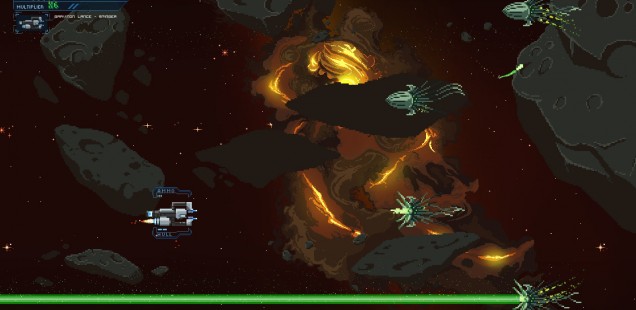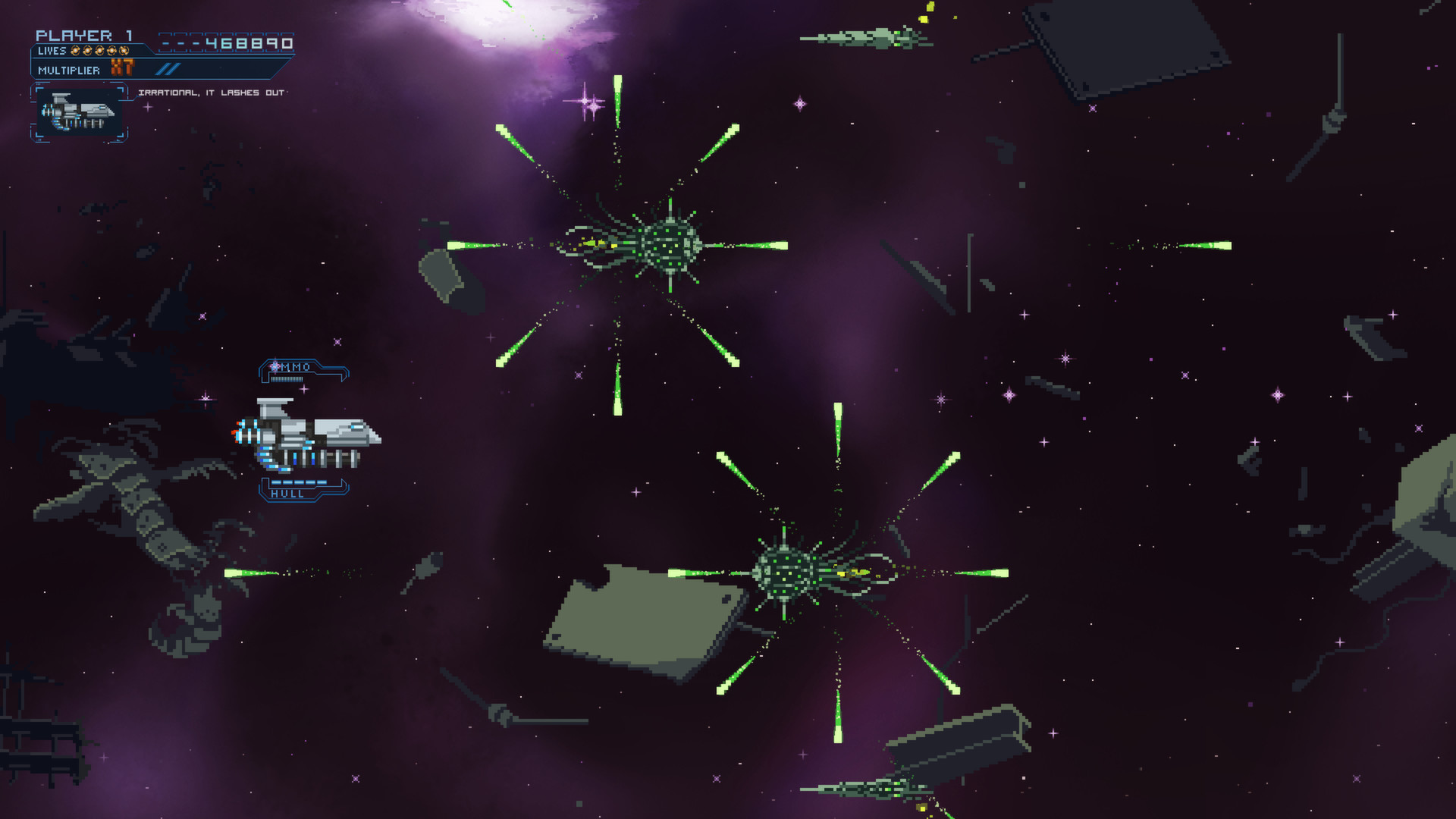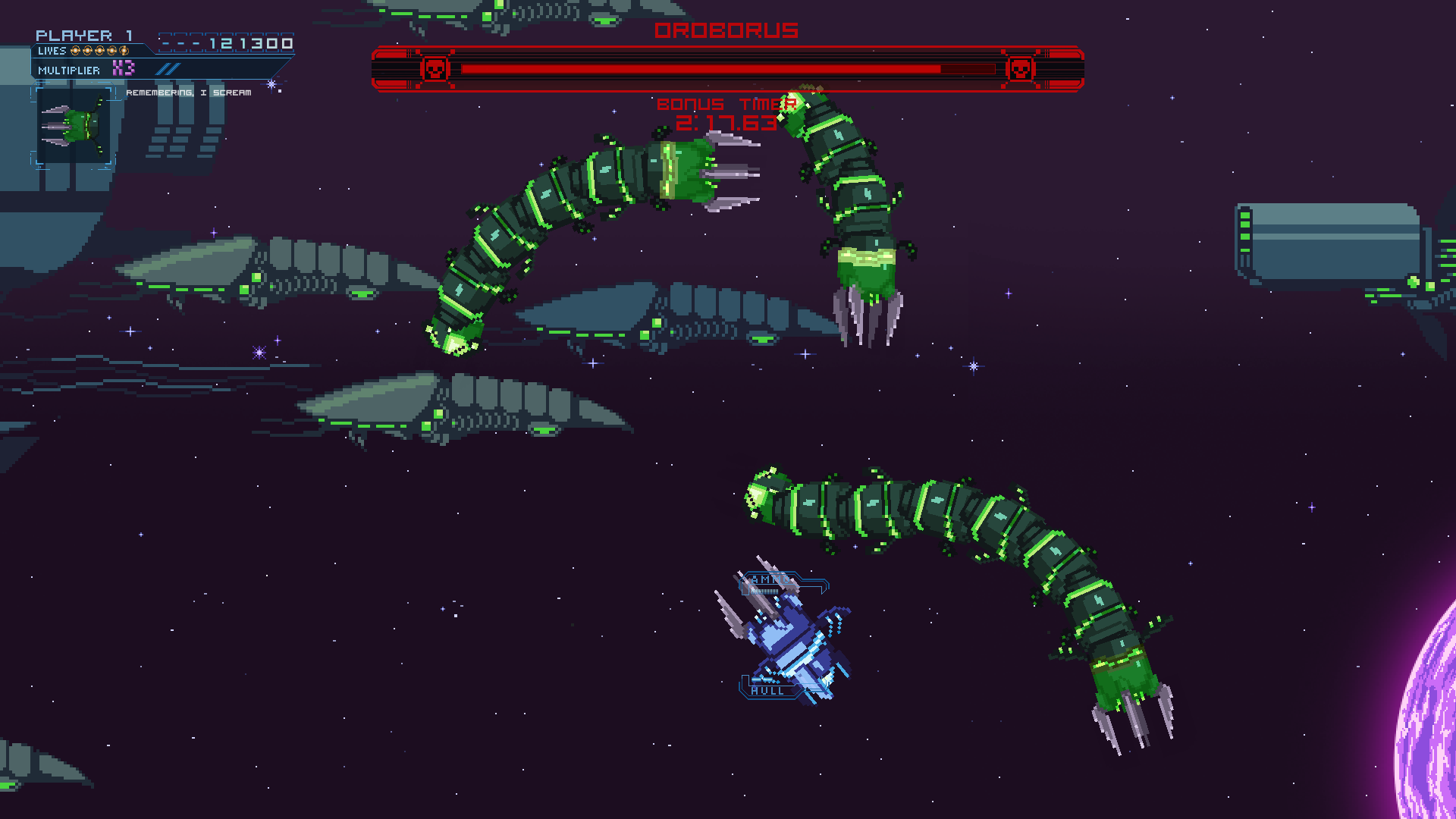
The Mind of a Storyteller
James Olchowski is impressed with the narrative depth on display in Enemy Mind.
Enemy Mind surprised me. It’s a game that has no need for a narrative. A truly old-school scrolling shooter, it could have simply presented me with a ship, some aliens to shoot, and called it a day. But it didn’t, and thank goodness it didn’t. It presented me with a narrative that was mostly left for me to unpack.
Enemy Mind spreads the narrative experience out over the course of the game, while deeply enmeshing it with player actions.
You’re introduced to the story following a small pixelated spacecraft as it flies along escorted by smaller fighters. Vaguely organic, sickly green spaceships then appear and attack, blowing it to bits. But wait! A small pod survived!Only there’s something odd going on. The bottom of the screen says “Press X to possess enemy ships”.
You don’t have to press X, you can float along in this pod, waiting for rescue. But eventually, you’ll get bored and follow that instruction. You’ll “hop” into a small Human Interceptor by firing a blue beam of energy at it. Immediately, the starships around you notice something is wrong with their former comrade, and open fire. Clearly, pacifism isn’t an option. The fight might be between those alien vessels and the human fleet, but no one’s going to tolerate a psychic parasite.
Already this is interesting. You play as something somewhat unusual: a bystander. A deadly bystander, for certain, but a bystander. Your motivation over the course of the game is not necessarily to stop the invading alien hordes and save humanity. It is simply to escape confinement and to avoid destruction on the way to freedom. Until the very end, your part in the story amounts to a sort of violent observation and inquiry.
 Whatever little ship you’re able to grab at the moment is never quite enough to get you out of this situation. They’re small things, fighters and missile boats for massive fleets. When you grab them, the rest of the humans and aliens nearby know that something has gone wrong, and they gun for you. You can’t imitate these creatures, just control them. The central mechanic of the game becomes, over and above shooting, the need to hop.
Whatever little ship you’re able to grab at the moment is never quite enough to get you out of this situation. They’re small things, fighters and missile boats for massive fleets. When you grab them, the rest of the humans and aliens nearby know that something has gone wrong, and they gun for you. You can’t imitate these creatures, just control them. The central mechanic of the game becomes, over and above shooting, the need to hop.
Hopping is the process by which the player’s psychic force takes over another mind and pilots the ship that person was piloting. This is accomplished by firing a sort of yourself-beam that emits from your current vessel before boomeranging back. If on the way out or back it hits another vessel, you hop into that one. Each ship in the game has limited ammunition, so you cannot make it through on a single brain. If you hop out of a vessel it will either continue to attack you, or it will go dead if it is drained of ammunition.
Each level of the game is split into several stages. At the end of each stage, you get a brief bit of text. Sometimes that text consists of the thoughts of the psi-being player-character, sometimes it consists of the thoughts of the person that your PC is currently inhabiting. Some of them seem like radio chatter from the fleet [“Interceptor? Why are you out of formation?”]. Sometimes, it’s difficult to tell where the thoughts are coming from.
These thoughts form the backbone of the game narrative. With no information to go on at the start, you’re left to piece together what you are and what’s going on via these snippets. At the end of each level, there’s a jump to hyperspace and a longer bit of text from the perspective of whichever race you’re currently inhabiting. These offer more insight into the back-story.
What struck me about the game is how effectively the central mechanic ties into the story being told. The storyline is static, immutable until the very end. No single action that the player or the player-character takes will affect the course of the story. This is something that might reasonably be seen as a major flaw in a game that takes narrative seriously. But it works for Enemy Mind. It allows the narrative to remain focused on delivering the maximum impact without the difficulty of juggling multiple storylines.
Rather than attempting to create a storyline with dozens of satisfying branches by tracking player choices and consequences, Enemy Mind tracks the sum of those choices. The player is presented with an ending that makes sense of the entire experience. This is satisfying in a way a lot of branched storylines aren’t able to manage for a variety of reasons.
 Many game narrative arguments hold analog role playing as the form to emulate. Characters should ideally possess of the most elaborate possible mental states, providing them with real character and motivation. Actions should have reactions that make sense in the context of the story being told. Players should enter a world and affect it in whatever manner they are capable of doing. Whether a player is let loose in an open world or inhabiting a pre-built character in a more straightforward narrative, the point of being a game is exploiting the unique ability of game story-lines to adapt.
Many game narrative arguments hold analog role playing as the form to emulate. Characters should ideally possess of the most elaborate possible mental states, providing them with real character and motivation. Actions should have reactions that make sense in the context of the story being told. Players should enter a world and affect it in whatever manner they are capable of doing. Whether a player is let loose in an open world or inhabiting a pre-built character in a more straightforward narrative, the point of being a game is exploiting the unique ability of game story-lines to adapt.
But this is an impossible goal. That doesn’t mean it’s not useful to chase, but there is likely never going to be a game that allows you to interact with a world in a granular manner and adjusts to suit the consequences of your actions. It’s an order of magnitude more difficult to produce real reactive events in a complex story.
In many modern games, there just isn’t the time and money available to create a gigantic branching bush of a storyline. Developers are inevitably faced with a conundrum: offer a unique experience based on player choices and accept that large portions of the game that cost enormous effort and money producing aren’t going to be seen by large portions of the player-base, or offer a less ambitious experience, the Mass Effect route of concrete story beats but with different emphasis depending on player action. That makes the reactive storyline unnecessary. If the character is always going to end up in the same basic place, why bother branching in the first place?
The fact that Enemy Mind leaves the player with the ship-swapping mechanic as the primary method for uncovering the storyline allows it to focus on a concept that’s easier for game narratives to investigate. It places all the narrative focus squarely on the moment-to-moment decisions made in combat.
At the end, there are three possible outcomes. These outcomes depend upon the contact your being has had with the warring races. Essentially, whichever ships you’ve inhabited most often are the people that successfully make you empathize with them. Their thoughts infect your thoughts, and shape you to the point that you go to bat for them. There is a third outcome, possible only if you find a mysterious purple “watcher” vessel, and keep it for the rest of the game. That outcome allows you to discover and return to your original purpose, abandoning the warring factions to take off into the unknown.
Each of these endings is a reasonable reflection of the sort of play that led to them. Rather than giving the player the impression that the choices made “didn’t matter”, as a vocal contingent of Mass Effect fans have complained, these endings are a direct reflection of player action. The ships that you find most comfortable to use, the player character winds up finding most comfortable to protect. A determination to discover the origin of the your player character is reflected in the ending that sees an escape from conflict into self-discovery.
I know why I saw what I did at the end of Enemy Mind, it was a reflection of my priorities and how I felt comfortable playing. I also know why I saw my particular ending in, for example, Dragon Age 2. I saw what I did because I chose a branch in the story that bore little resemblance to my actual play. A place where blood magic was a dangerous force to be reckoned with, and not a slightly fiddly but useful branch of magic that I used every single day without consequence.
 Dragon Age 2 was billed as a very reactive game, all set in one city that would change over the course of play. Choices were supposed to have consequences. In the world of Dragon Age, blood magic is the darkest of the dark arts. Its mages are already reviled and distrusted, so mages who use the blood of innocent victims to power themselves and can control minds are especially horrendous. Throughout the narrative told in cutscenes and conversations, blood magic is referred to as the ultimate in disgusting abuse. It’s held in only slightly less contempt than cannibalism.
Dragon Age 2 was billed as a very reactive game, all set in one city that would change over the course of play. Choices were supposed to have consequences. In the world of Dragon Age, blood magic is the darkest of the dark arts. Its mages are already reviled and distrusted, so mages who use the blood of innocent victims to power themselves and can control minds are especially horrendous. Throughout the narrative told in cutscenes and conversations, blood magic is referred to as the ultimate in disgusting abuse. It’s held in only slightly less contempt than cannibalism.
Which made it slightly ridiculous that my mage was using blood magic all the time. Heck, she was frequently using blood magic during a cutscene. Dripping protective eldritch blood on the ground while someone warned us all about the dark arts. It grew more silly as the story went on and more beats relied on the protagonist definitely not being a blood mage.
Characters trained to sense the subtlest hint of illegal magic somehow ignored the bloody-robed person holding a glowing stick walking in the town square. Many characters lost themselves to the call of Blood Magic and became abominations, lacking my protagonist-only resistance to inconvenient possession. There were no consequences to my choice to explore the forbidden arts whatsoever. The gameplay was never able to re-sync with the narrative.
Enemy Mind never had these issues. It is a quick, effective argument in favor of using player goals during gameplay to drive narrative rather than creating a separate accounting of choice and consequence. This method comes with challenges and limitations, but it comes with the benefit of focus and a sense of meaningful play. Without it, the games may feel meaningful, but the stories never will.
James Olchowski can be found on Valley Nerd Watch, on Twitter, and on Facebook.